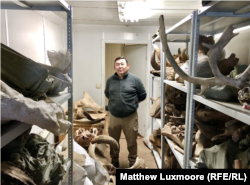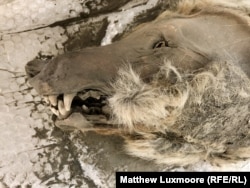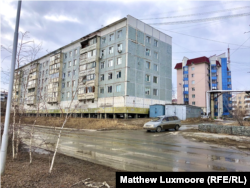YAKUTSK, Russia -- Paleontologist Valery Plotnikov reached into an industrial freezer to retrieve a Styrofoam box and lifted the lid. Inside, curled up into a ball as if comfortably napping, was a brown, furry creature resembling nothing alive on the planet today.
"We initially thought it was a cave wolf, or a bear of some sort," said Plotnikov, a researcher at the Russian Academy of Sciences branch in Yakutsk, capital of Russia's Sakha Republic, or Yakutia. "But its teeth don't match, and it has fewer toes."
The animal had been dead for thousands of years, but it was discovered almost perfectly preserved in the Siberian permafrost. It has not yet been dated by scientists, but Plotnikov estimates that it may have been frozen more than 50,000 years ago, which would make it one of the oldest finds analyzed by his laboratory.
That would be quite an achievement. Plotnikov's lab is packed with so many ancient bones and specimens that it is struggling to find space for the Ice Age remains that are rising to the surface as the climate warms. And the pace of discovery is accelerating as the frozen ground that covers 95 percent of Yakutia thaws, and attracts scientists from around the world to this remotest of regions.
It's also attracting a booming trade in mammoth tusks, which sell for tens of thousands of dollars in neighboring China. Sakha residents scour the land in search of windfall -- and usually illicit -- profits, and in the process they unearth dozens of ancient carcasses preserved in the ice, which shed light on the history of the human race and many of the species that have become extinct.
"The revolution that's happened in DNA sequencing technology is insane. It's been a struggle to keep up," said Love Dalen, a professor of evolutionary genetics at the Center for Palaeogenetics in Stockholm. "It's probably one of the most rapid shifts in technology that has ever happened in science."
"We used to sequence results that you could print out on an A4 page in Arial font," he said. "Today, if we printed out the DNA codes we sequence, it would get you to the moon and back -- twice."
Chasing The Mammoth
Using these advances in technology, Dalen and other scientists have reached new conclusions about the evolution and historical lineage of animals alive today, and stoked an intensifying and controversial race to use the DNA from ancient bones to genetically reengineer the most mythic ancient creature of all -- the woolly mammoth.
A project led by geneticist George Church at Harvard University is working to edit the genes of the African elephant, the mammoth's closest living relative, to recreate a mammoth-like creature with fur, small ears, and a thick layer of fat to withstand the Siberian cold. A synthetic uterus under development in Church's laboratory would become the first ever to produce a mammal of any sort -- let alone one with a 22-month gestation period.
Some hope the project will help humans atone for their role in driving the creature to extinction between 10,000 and 4,000 years ago. Others say resurrecting the mammoth in a warming climate would be akin to repeating those sins all over again.
Dalen has made 10 field trips to Siberia since he began collaborating with Plotnikov and other Russian researchers in the early 2000s. At least 80 percent of the world's known mammoth remains are thought to be in Yakutia, and half of its intact Ice Age specimens. During a visit in 2018, the team took DNA samples from the head of a Pleistocene-era steppe wolf, a large intact mammoth foot, and the body of a cave lion cub that was frozen for 28,000 years and is probably the best-preserved Ice Age animal ever found.
But the as-yet-undated brown-furred animal found last summer still poses a mystery, and Dalen plans a return trip to Yakutsk in August to take samples so he can study the creature's DNA at his lab in Stockholm. "From the photos I've seen, it looks like a cat of some sort," he said. "But we can't be sure."
Vicious Circle
The pace of discovery may be a boon for researchers like Dalen, but it also testifies to a troubling reality. The world's permafrost covers an area twice the size of the United States, and its carbon emissions are accelerating as the climate warms. It's the kind of vicious feedback loop that characterizes many of the processes of warming in the Arctic.
The wintertime thaw in Siberia is paradoxically exacerbated by snow, which preserves summer heat in the soil like a blanket. As the active layer stops freezing in winter, the extra warmth allows microbes in the soil to chomp on the thawing organic material, emitting carbon dioxide or methane -- a greenhouse gas 25 times more potent -- year-round.
The warmth spreads deeper into the permafrost, accelerating its thaw, and in built-up areas it weakens the foundations of homes that stand on stilts dug deep into the ground, forcing some residents to evacuate. Temperature records in Russia have been obliterated in recent years, fueling raging wildfires in Siberia and heatwaves in its traditional "poles of cold."
Recreating Pastures
In the far northeastern corner of Yakutia, about 1,600 kilometers from Yakutsk, ecologist Sergei Zimov and his son Nikita have created what they call Pleistocene Park, a 145-square-kilometer plot of land that they have turned into a live experiment in reversing the effects of climate change. To halt the thawing of permafrost, they are repopulating the area with the wild animals -- bison, muskox, reindeer, horses -- that roamed those plains in the last Ice Age. As they tamp down the deep snow and allow the trapped heat to escape, the animals are also locking the cold inside the frozen earth.
"It is very hard to agree to reduce industrial CO2 emissions. Reducing permafrost emissions [is] much easier," Sergei Zimov wrote in a 1988 manifesto laying out his bold ambition. "All [that's] needed is to cross mental barriers, accept that pasture ecosystems have a right for living and freedom, and return part of the territory which our ancestors took from them."
Pleistocene Park now has around 200 grazers, which Nikita Zimov says is already keeping the soil cooler than in the surrounding area. To really slow climate change, however, the Zimovs will need hundreds of thousands of animals across millions of acres in the Arctic. They'll also, they say, need mammoths. Having teamed up with Harvard's Church, they hope to one day have them stomping around Pleistocene Park, toppling trees and clearing the area for steppe.
That could be decades away, if it ever happens. But for many of the scientists working in Yakutsk, it's a vision worth cheering.
At the city's Mammoth Museum, which specializes in ancient specimens, Sergei Fyodorov has spent years studying the mammoth remains kept in a room-size freezer behind the main museum hall. He says he has never gotten used to the cloying smell of mammoth meat, which clings to his clothes and elicits glances from his fellow bus passengers.
The Yakut language, Fyodorov says, has words for camel and lion but no word for mammoth. He suggests that may indicate that the ethnic group is not indigenous to the region but native to climes further south.
Yet it may be the Yakuts who will one day become the masters of a new mammoth steppe. There is no region better suited to reintroducing the extinct creature, according to Plotnikov.
"The climate of central Yakutia has many of the characteristics of the Pleistocene Period, with forests, valleys, and grassland," he said.
For Fyodorov, seeing the enormous beasts again roam the Siberian flatlands would be a culmination of a life of research.
"If we manage to recreate the mammoth," he said. "Yakutia is ready to host it."

















